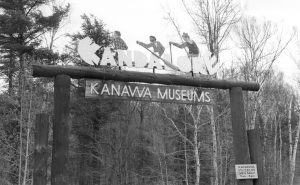KANAWA CANOES ON THE MOVE 1985 by B.M.
The world’s “largest, most comprehensive collection of canoes” is preparing to move, according to Michael Ketemer, Kanawa Canoe Museum’s manager, researcher, guide, custodian …Varying from birch bark to fiberglass, from the early 20th century to 1985, this collection of canoes from around the world is outgrowing its present residence. And there’s no sign suggesting an end to that growth.

In order to make the canoes more accessible to the public the museum will move to two locations, Haliburton and Port Hope. Because the Village of Haliburton has been so supportive to the birth and development of Kanawa it seemed only logical to open a museum there. In Port Hope the canoes will move into the old Nicholson File Factory, an historic building on the Ganaraska River. As there are many duplicates a good representation will be on display at both sites.
And how has the canoe museum been accepted over the years?
Approximately five thousand people have toured it in the last one and a half years.
Michael Ketemer takes pride in talking about the pleasures of being curator.
“Some very nice things happen. For instance I meet people from all over the world. And there are the old timers who tell me they built canoes back in the 20s.”
“Once a week some gentleman will recognize a ‘Walter Dean Sunnyside Pleasure Cruiser’ and tell me how he met his wife in one while vacationing at Centre Island.”
A recent immigre, Joseph Roth, violinist, paid Kanawa a visit. It was -30C and he told Michael that when they played in Siberia it was so cold that the fiddle players protested (“We on striking”) and consented to perform if permitted to wear kid gloves while playing. To show his appreciation of Michael’s personal tour Mr. Roth played a Mississippi Hoe Down Reel and a Russian Sailor Song. Just him, Michael and the canoes.
From the parking lot it’s an enjoyable stroll to the museum down the Heritage Trail, an adventure past a giant steam engine, pioneer dwellings and pioneer tools.
For now, and next year at least, Kanawa will remain at its present location until the endless moving details are worked out.
The Kanawa Museum is located on Highway #35, south of Dorset (30km or 19 miles) north of Minden. Look for the huge Camp Kandalore sign with three voyageurs paddling their freighter canoe. There is an admission fee of $2.00 per adult, $1.00 per student 18 and under plus Seniors; children are free. The museum is open every day during the summer from 9 a.m. to 6 p.m. In the winter you should phone ahead (705-489-2644). The mailing address is: RR2, Minden, Ont. K0M 2K0.

More Information
In fact the museum exhibits kayaks, rowboats and paddles of various designs as well. More than 600 craft to date. The collection is a dream of Kirk Wipper, both a University of Toronto professor and owner of Camp Kandalore. The birch bark canoe played a significant role in the exploration and discovery of Canada’s waterways. The craft are restored to appear as they did originally. One rare canoe from Alaska is believed to have come overland from Asia. It has a flat bottom, elaborate framework and is embellished with Chinese trading beads. A balsa canoe made by Quichua Indians of Peru’s Lake Titicaca is constructed of reeds and twine. It was intended for use on calm water and to be poled as versus paddled. The design closely resembled that of craft originating in Egypt and Central Africa.
A massive dugout from the west coast of Canada features original paintwork and is believed to be about 200 years old. A bark canoe made by the Penobscot tribe about 1870 is decorated below the gunwales. A Haida dugout has the markings of an eagle, applied to frighten sea monsters. The eagle was also applied to the paddles as they are dipped into the water. A most interesting craft on display was built during WW2 by the survivors of the German battleship Bismarck while they were in a prisoner-of-war camp north of Lake Superior. (As an aside Kirk Wipper was a Canadian naval officer serving on the North Atlantic during WW2.) The kayak comprises scrap material and odd pieces of wood with metal ribs fashioned from old barrel hoops. A large rudder was controlled by leather strings running through the cockpit. Ten of the kayaks were built for recreational purposes. None were used for escape. A wood planked canoe made around the turn of the century has a backrest for relaxation and dates from a time when canoes were built for comfort and roomy to accommodate women wearing long skirts. Also, a well-worn canvas canoe used to survey the Ontario/Manitoba border has metal parts of brass so they would not rust.
Following WW2 some companies making aircraft parts began manufacturing aluminum canoes. One canoe was designed to split into two halves along the keel to be lashed to a plane’s pontoon for balance.
A Montreal canoe was replicated that carried 14 paddlers during the fur trade between Montreal and Lake Superior. Also included is a pointer boat used to maneuver log booms during spring drives and sometimes modified to accommodate a cook’s kitchen.
For more detail and photos search for The Canadian Canoe Museum on this website.

Photo of Kirk Wipper.
